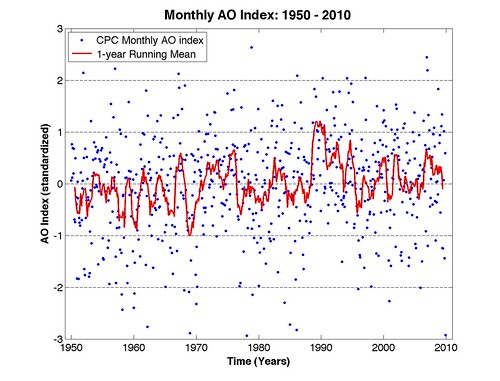Unhypnotized
Truth feeder
ANDREW C. REVKIN
NY Times
Friday, Jan 1st, 2010
The unusual *pattern of atmospheric high and low pressure over and around the Arctic that has contributed to the recent snow and cold from Alabama to *Washington, to *East Anglia, England (and *rain and warmth along the west coast of Greenland) is also an important influence on *the shifting sheath of sea ice on the Arctic Ocean.
Several specialists studying Arctic sea ice told me that there’s a good chance that, if current conditions persist, the ice this spring could be in better shape than it has been over the last few years. In all of this, though, it’s important to step back from the lure of the moment, which quickly attracts bursts of attention from climate commentators when conditions favor *one view or *another, and examine long-term trends.
Apture™

 by Andrew Revkin
by Andrew Revkin
The polar pressure pattern, called the *Arctic Oscillation (often abbreviated as A.O.), is deep in its negative phase at the moment — a depth not seen since the 1980s, according to *Ignatius Rigor of the Polar Science Center at the University of Washington. Look at the lower right-hand corner of the graph above to see a blue dot signifying current conditions. But also be sure to note the red line indicating the running trend, which is slowly toward the positive side.
The fate of *sea ice in the Arctic Ocean is determined by a complicated mix of factors, including the pressure changes, with the biggest loss of old thick ice resulting more from a great “flush” of floes than melting, Dr. Rigor and many other scientists tracking the region say. (Watch the animation below, provided by Dr. Rigor, to see the importance of motion in shaping ice conditions.)
Full article here
Source...
NY Times
Friday, Jan 1st, 2010
The unusual *pattern of atmospheric high and low pressure over and around the Arctic that has contributed to the recent snow and cold from Alabama to *Washington, to *East Anglia, England (and *rain and warmth along the west coast of Greenland) is also an important influence on *the shifting sheath of sea ice on the Arctic Ocean.
Several specialists studying Arctic sea ice told me that there’s a good chance that, if current conditions persist, the ice this spring could be in better shape than it has been over the last few years. In all of this, though, it’s important to step back from the lure of the moment, which quickly attracts bursts of attention from climate commentators when conditions favor *one view or *another, and examine long-term trends.
Apture™


The polar pressure pattern, called the *Arctic Oscillation (often abbreviated as A.O.), is deep in its negative phase at the moment — a depth not seen since the 1980s, according to *Ignatius Rigor of the Polar Science Center at the University of Washington. Look at the lower right-hand corner of the graph above to see a blue dot signifying current conditions. But also be sure to note the red line indicating the running trend, which is slowly toward the positive side.
The fate of *sea ice in the Arctic Ocean is determined by a complicated mix of factors, including the pressure changes, with the biggest loss of old thick ice resulting more from a great “flush” of floes than melting, Dr. Rigor and many other scientists tracking the region say. (Watch the animation below, provided by Dr. Rigor, to see the importance of motion in shaping ice conditions.)
Full article here
Source...
